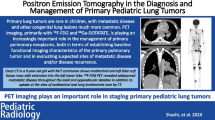Abstract
Objective
The objective of this study was to evaluate the prevalence and positron emission tomography (PET) imaging features of pulmonary drug toxicity in patients with lymphoma during or just following chemotherapy.
Methods
A total of 677 PET scans on 460 patients with lymphoma (351 non-Hodgkin’s lymphoma, 92 Hodgkin’s disease, and 17 both Hodgkin’s and non-Hodgkin’s lymphoma) were performed for the evaluation of chemotherapy response. In 51 patients, abnormal accumulation on both sides of the chest was reported. A review of medical records, 18fluorodeoxyglucose (18FDG)-PET scans, and chest computed tomography (CT) was performed, and cases with probable drug toxicity were identified. Inclusion criteria of probable drug toxicity were abnormal but symmetrical FDG accumulation in both lungs seen during or just following the completion of chemotherapy, the abnormal accumulation or corresponding abnormal CT findings resolved on sub sequent studies, exclusion of clinical diagnosis of pneumonia, radiation pneumonitis, or lymphoma involvement.
Results
In 10 patients (six men and four women, average age 47.3), 2.2% of cases, probable drug toxicity was identified. In all 10 cases, diffuse and subpleural-dominant FDG accumulation was seen on FDG-PET scans, and scattered or diffuse ground-glass opacities were observed on chest CT. Four patients reported symptoms, and six patients did not report any symptoms.
Conclusions
Diffuse and peripheral-dominant FDG accumulation in the lung, which may represent pulmonary drug toxicity, was not uncommon in patients with lymphoma who underwent chemotherapy. FDG-PET scan might be able to detect pulmonary drug toxicity in asymptomatic patients.
Similar content being viewed by others
References
Kostakoglu L, Goldsmith SJ. 18F-FDG PET evaluation of the response to therapy for lymphoma and for breast, lung, and colorectal carcinoma. J Nucl Med 2003;44:224–239.
Kazama T, Faria SC, Varavithya V, Phongkitkarun S, Ito H, Macapinlac HA. FDG PET in the evaluation of treatment for lymphoma: clinical usefulness and pitfalls. Radiographics 2005;25:191–207.
Castellucci P, Zinzani PL, Pourdehnad M, Alinari L, Nanni C, Farsad M, et al. 18F-FDG PET in malignant lymphoma: significance of positive findings. Eur J Nucl Med Mol Imaging 2005;32:749–756.
de Wit M, Bohuslavizki KH, Buchert R, Bumann D, Clausen M, Hossfeld DK. 18FDG-PET following treatment as valid predictor for disease-free survival in Hodgkin’s lymphoma. Ann Oncol 2001;12:29–37.
Sleijfer S. Bleomycin-induced pneumonitis. Chest 2001;120:617–624.
Rossi SE, Erasmus JJ, McAdams HP, Sporn TA, Goodman PC. Pulmonary drug toxicity: radiologic and pathologic manifestations. Radiographics 2000;20:1245–1259.
Barrington SF, O’Doherty MJ. Limitations of PET for imaging lymphoma. Eur J Nucl Med Mol Imaging 2003;30:S117–S127.
Hain SF, Beggs AD. Bleomycin-induced alveolitis detected by FDG positron emission tomography. Clin Nucl Med 2002;27:522–523.
Kirsch J, Arrossi AV, Yoon JK, Wu G, Neumann DR. FDG positron emission tomography/computerized tomography features of bleomycin-induced pneumonitis. J Thorac Imaging 2006;21:228–230.
Lowe VJ, Fletcher JW, Gobar L, Lawson M, Kirchner R, Valk P, et al. Prospective investigation of positron emission tomography in lung nodules. J Clin Oncol 1998;16:1075–1084.
Luna MA, Bedrossian CW, Lichtiger B, Salem PA. Interstitial pneumonitis associated with bleomycin therapy. Am J Clin Pathol 1972;58:501–510.
Hassaballa HA, Cohen ES, Khan AJ, Ali A, Bonomi P, Rubin DB. Positron emission tomography demonstrates radiation-induced changes to nonirradiated lungs in lung cancer patients treated with radiation and chemotherapy. Chest 2005;128:1448–1452.
Lyburn ID, Lowe JE, Wong WL. Idiopathic pulmonary fibrosis on F-18 FDG positron emission tomography. Clin Nucl Med 2005;30:27.
Author information
Authors and Affiliations
Corresponding author
Rights and permissions
About this article
Cite this article
Kazama, T., Faria, S.C., Uchida, Y. et al. Pulmonary drug toxicity: FDG-PET findings in patients with lymphoma. Ann Nucl Med 22, 111–114 (2008). https://doi.org/10.1007/s12149-007-0089-9
Received:
Accepted:
Published:
Issue Date:
DOI: https://doi.org/10.1007/s12149-007-0089-9




